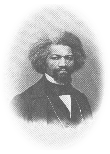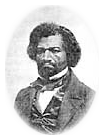Frederick Douglass Biography
 Frederick Douglass was born in a slave cabin, in February, 1818, near the town of
Easton, on the Eastern Shore of Maryland. He was separated from his mother when only
a few weeks old he was raised by his grandparents. At about the age of six, his grandmother
took him to the plantation of his master and left him there. Not being told by her
that she was going to leave him, Douglass never recovered from the betrayal of the
abandonment. When he was about eight he was sent to Baltimore to live as a houseboy
with Hugh and Sophia Auld, relatives of his master. It was shortly after his arrival
that his new mistress taught him the alphabet. When her husband forbade her to continue
her instruction, because it was unlawful to teach slaves how to read, Frederick took
it upon himself to learn.
Frederick Douglass was born in a slave cabin, in February, 1818, near the town of
Easton, on the Eastern Shore of Maryland. He was separated from his mother when only
a few weeks old he was raised by his grandparents. At about the age of six, his grandmother
took him to the plantation of his master and left him there. Not being told by her
that she was going to leave him, Douglass never recovered from the betrayal of the
abandonment. When he was about eight he was sent to Baltimore to live as a houseboy
with Hugh and Sophia Auld, relatives of his master. It was shortly after his arrival
that his new mistress taught him the alphabet. When her husband forbade her to continue
her instruction, because it was unlawful to teach slaves how to read, Frederick took
it upon himself to learn.
He made the neighborhood boys his teachers, by giving away his food in exchange for lessons in reading and writing. At about the age of twelve or thirteen Douglass purchased a copy of The Columbian Orator, a popular schoolbook of the time, which helped him to gain an understanding and appreciation of the power of the spoken and the written word, as two of the most effective means by which to bring about permanent, positive change.
Returning to the Eastern Shore, at approximately the age of fifteen, Douglass became a field hand, and experienced most of the horrifying conditions that plagued slaves during the 270 years of legalized slavery in America. But it was during this time that he had an encounter with the slave breaker Edward Covey. Their fight ended in a draw, but the victory was Douglass’, as his challenge to the slave breaker restored his sense of self-worth. After an aborted escape attempt when he was about eighteen, he was sent back to Baltimore to live with the Auld family, and in early September, 1838, at the age of twenty, Douglass succeeded in escaping from slavery by impersonating a sailor.
He went first to New Bedford, Massachusetts, where he and his new wife Anna Murray
began to raise a family. Whenever he could he attended abolitionist meetings, and,
in October, 1841, after attending an anti-slavery  convention on Nantucket Island, Douglass became a lecturer for the Massachusetts Anti-Slavery
Society and a colleague of William Lloyd Garrison. This work led him into public speaking
and writing. He published his own newspaper, The North Star, participated in the first
women’s rights convention at Seneca Falls, in 1848, and wrote three autobiographies.
He was internationally recognized as an uncompromising abolitionist, indefatigable
worker for justice and equal opportunity, and an unyielding defender of women’s rights.
He became a trusted advisor to Abraham Lincoln, United States Marshal for the District
of Columbia, Recorder of Deeds for Washington, D.C., and Minister-General to the Republic
of Haiti.
convention on Nantucket Island, Douglass became a lecturer for the Massachusetts Anti-Slavery
Society and a colleague of William Lloyd Garrison. This work led him into public speaking
and writing. He published his own newspaper, The North Star, participated in the first
women’s rights convention at Seneca Falls, in 1848, and wrote three autobiographies.
He was internationally recognized as an uncompromising abolitionist, indefatigable
worker for justice and equal opportunity, and an unyielding defender of women’s rights.
He became a trusted advisor to Abraham Lincoln, United States Marshal for the District
of Columbia, Recorder of Deeds for Washington, D.C., and Minister-General to the Republic
of Haiti.
